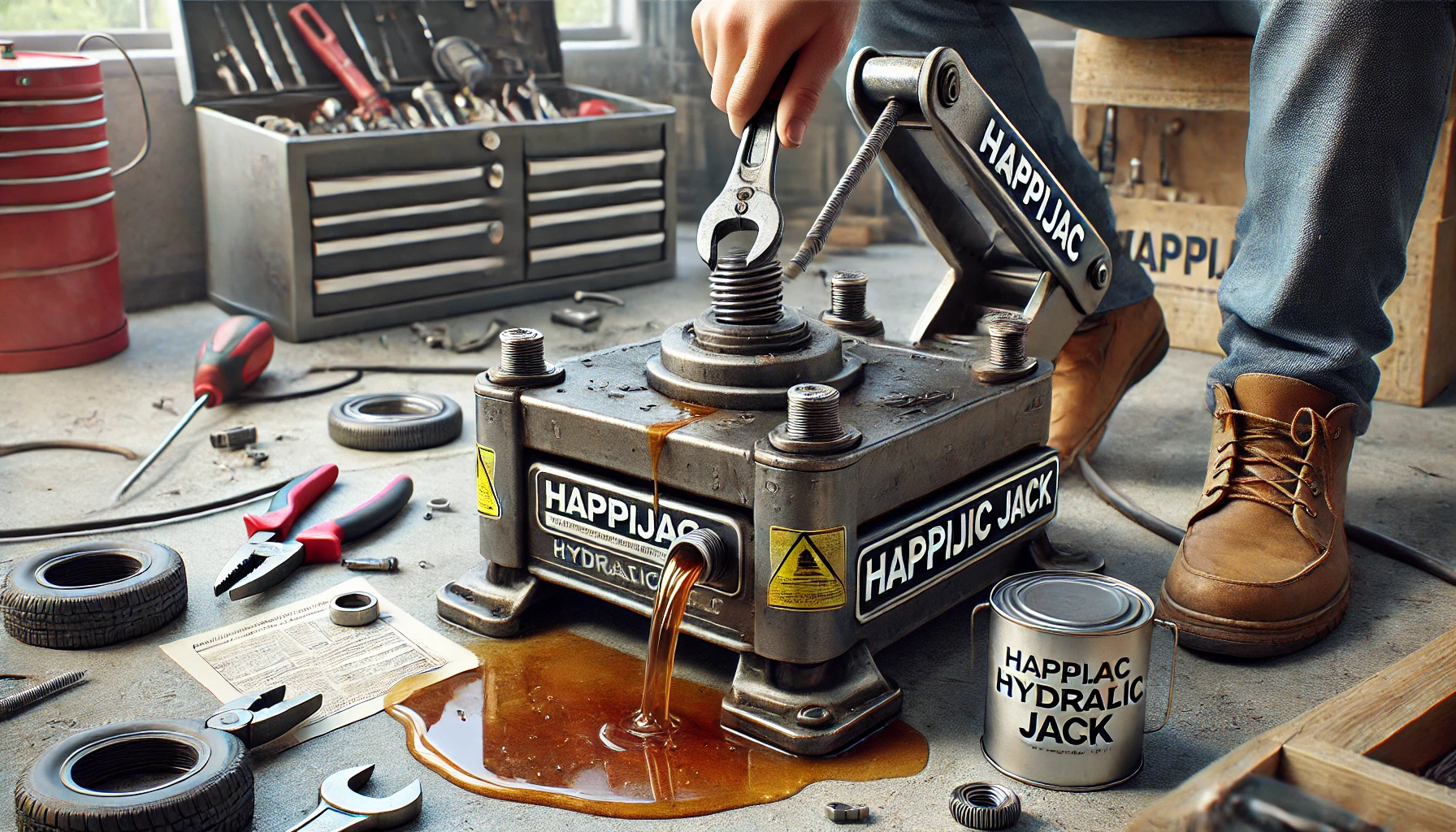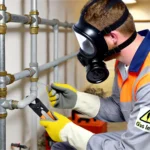- Introduction: Why Is Your HappiJac Hydraulic Jack Leaking?
- Common Causes of a Leaking HappiJac Hydraulic Jack
- Can You Fix a Leaking HappiJac Hydraulic Jack Yourself?
- Step-by-Step Guide: How to Fix a Leaking HappiJac Hydraulic Jack
- How to Prevent Future Leaks in a HappiJac Hydraulic Jack
- Signs That Your HappiJac Hydraulic Jack Needs Professional Repair
- FAQs About Fixing a Leaking HappiJac Hydraulic Jack
- Conclusion: Keep Your HappiJac Hydraulic Jack in Optimal Condition
Introduction: Why Is Your HappiJac Hydraulic Jack Leaking?
A HappiJac hydraulic jack is a tool used to lift heavy loads, commonly found on RVs, trucks, and other large vehicles. It works by using hydraulic pressure to raise and lower objects smoothly. Over time, though, the hydraulic system can develop problems, including leaks.
When your HappiJac hydraulic jack starts leaking, you’ll likely notice oil puddles underneath the jack or a slow and inefficient operation. The jack may not lift as smoothly as before, or it might require more effort to raise a load. These signs indicate that there is a leak somewhere in the hydraulic system, and it’s important to address the issue quickly.
So, can you fix a leaking HappiJac hydraulic jack? Yes, and in this guide, we’ll cover everything you need to know to fix the leak and keep your jack working properly.
Common Causes of a Leaking HappiJac Hydraulic Jack
Understanding the common causes of a leaking HappiJac hydraulic jack can help you fix the problem quickly and avoid future issues. Below are the most typical reasons why your jack may start leaking.
Worn-Out Seals
The seals in a hydraulic jack are designed to keep the fluid inside and maintain pressure. Over time, these seals wear out due to regular use, exposure to dirt, and changes in temperature. When the seals get old or damaged, they allow hydraulic fluid to escape, which results in a leak. If you notice oil puddles around your jack, worn-out seals are often the culprit.
Damaged Hydraulic Lines
Hydraulic lines carry the fluid that powers your jack. If these lines develop cracks, pinholes, or other damage, they can cause leaks. Lines can become damaged through wear and tear or exposure to harsh environments. Even a small hole can lead to significant fluid loss, making your HappiJac hydraulic jack less efficient and prone to malfunction.
Overfilled Hydraulic Reservoir
Filling the hydraulic reservoir beyond its recommended level can lead to excess pressure inside the system. This excess pressure can force fluid out through weak spots, causing a leak. It’s essential to check the fluid levels regularly and avoid overfilling to prevent this issue.
Normal Wear and Tear
Like any mechanical equipment, a HappiJac hydraulic jack experiences natural wear and tear over time. Regular usage gradually wears down internal components, including seals, valves, and lines, making leaks more likely as the jack ages. Routine maintenance can help delay these effects, but eventually, parts may need to be repaired or replaced to stop leaks.
Can You Fix a Leaking HappiJac Hydraulic Jack Yourself?
Yes, you can fix a leaking HappiJac hydraulic jack yourself, especially if the leak is due to common issues like worn-out seals or damaged hydraulic lines. Many of the problems that cause leaks are straightforward to fix with the right tools and a little patience. If you’re comfortable working with tools, a DIY repair is definitely possible for most people.
Basic Tools and Supplies Needed
To fix common hydraulic leaks in a HappiJac jack, you’ll need some basic tools and supplies:
- Replacement seals (specific to your jack model)
- Hydraulic fluid (check the manual for the correct type)
- Wrenches or socket set for removing parts
- Screwdrivers for accessing internal components
- Silicone sealant (if needed to reinforce seals)
- Clean rags to wipe up excess fluid
With these tools, you can typically handle most minor repairs on your own. For example, if the leak is caused by worn-out seals, you can replace them and refill the hydraulic fluid to stop the leak.
When to Seek Professional Help
While many fixes are simple, there are times when professional help might be needed. If the leak continues after you’ve replaced seals or fixed lines, there may be an underlying issue, such as internal damage to the hydraulic system. Additionally, if you’re dealing with a complicated hydraulic system or if the jack is tied to heavy equipment, it’s better to leave it to a professional. In these cases, getting expert assistance will ensure the job is done correctly and safely.
Step-by-Step Guide: How to Fix a Leaking HappiJac Hydraulic Jack
If you’re ready to fix your leaking HappiJac hydraulic jack, follow these easy steps to get the job done. This guide will walk you through the process, so your jack can be back to working smoothly.
Step 1: Identify the Leak Source
The first step to fixing your HappiJac hydraulic jack is finding the exact spot where the leak is coming from. Look for any visible signs of fluid around the seals, hydraulic lines, or fittings. Oil puddles near the jack, wet spots, or dripping fluid are clear signs of where the leak is happening. Pay special attention to the seals and connections, as these are common areas where leaks occur.
Step 2: Drain the Hydraulic Fluid
Before you can make any repairs, you’ll need to safely drain the hydraulic fluid. Place a container under the jack to catch the fluid and slowly release it by loosening the fluid plug or valve. Draining the fluid allows you to access the leaking area without causing more mess. Make sure all the fluid is emptied before you proceed with any repairs.
Step 3: Replace or Repair Damaged Seals
If you’ve identified worn-out or damaged seals, now is the time to replace them. Seals are often the main cause of leaks, and they can be easily replaced. Purchase replacement seals that match your specific HappiJac model. Once you have the new seals, remove the old ones using a screwdriver or wrench, and carefully install the new seals in their place. Be sure everything is clean and properly seated before moving on.
Step 4: Inspect and Repair Hydraulic Lines
Next, inspect the hydraulic lines for any cracks, pinholes, or other damage. Even a small hole in the line can cause a noticeable leak. If you find any damaged lines, replace them with new ones. Make sure the new lines are securely connected and free of any defects that could lead to future leaks.
Step 5: Refill Hydraulic Fluid
Once the seals and lines are repaired, it’s time to refill the hydraulic fluid. Make sure you use the correct type of hydraulic fluid recommended by the manufacturer. Slowly refill the jack’s reservoir until it reaches the appropriate level, being careful not to overfill. Proper fluid levels are key to maintaining pressure and preventing leaks.
Step 6: Test the Hydraulic Jack
After refilling the hydraulic fluid, it’s important to test the jack to ensure everything is working correctly. Operate the jack as you normally would, checking for any signs of continued leaks. If the jack lifts smoothly and there are no fluid leaks, your repair was successful. Continue to monitor the jack for a few days to ensure the leak is fully fixed.
How to Prevent Future Leaks in a HappiJac Hydraulic Jack
To keep your HappiJac hydraulic jack working smoothly and avoid future leaks, it’s essential to follow some basic preventive measures. Regular care and attention can help extend the life of your jack and save you from costly repairs down the road.
Regular Maintenance Tips
Regular inspections and maintenance are key to preventing leaks in your hydraulic jack. Make it a habit to check for any signs of wear or damage to the seals and hydraulic lines. Lubricate the moving parts as recommended by the manufacturer to reduce friction and ensure smooth operation. Catching potential issues early, like small cracks or worn seals, will help prevent major leaks from occurring later.
Avoid Overloading
Overloading your HappiJac hydraulic jack can lead to premature wear and tear. Each jack has a maximum weight limit, and exceeding that limit puts extra strain on the seals and hydraulic system, increasing the risk of leaks. Always check the weight of the load you’re lifting and make sure it doesn’t exceed the jack’s capacity. Keeping the load within the recommended range will help prolong the life of the jack.
Check Hydraulic Fluid Levels
Keeping an eye on the hydraulic fluid levels is crucial for maintaining the jack’s performance. Low fluid levels can cause the jack to work harder, which may lead to leaks. Make sure to check the fluid levels regularly, especially before using the jack. Top off the fluid as needed to ensure proper function, and always use the type of fluid recommended for your specific HappiJac model.
Store the Jack Properly
Proper storage is another way to prevent future leaks. When the jack is not in use, store it in a clean, dry place to avoid exposure to moisture and dirt, which can damage seals and lines. It’s also a good idea to release any pressure from the hydraulic system before storing the jack. Keeping it in a cool, dry location and away from extreme temperatures will help protect the components and prevent leaks over time.
Signs That Your HappiJac Hydraulic Jack Needs Professional Repair
While many leaks in a HappiJac hydraulic jack can be fixed with basic tools and a little DIY effort, some issues require professional repair. Here are the signs that it’s time to seek expert help to fix your leaking HappiJac hydraulic jack.
Severe Leaks or Structural Damage
If your jack has severe leaks, especially ones involving large amounts of fluid, it’s a clear sign that professional help is needed. Structural damage, such as cracks in the body of the jack or major faults in the hydraulic system, is beyond the scope of a typical DIY fix. These types of problems often require specialized tools and knowledge to repair properly, and using the jack in this condition could be dangerous.
Repeated Fluid Leaks After Repairs
If you’ve tried to fix the leaking HappiJac hydraulic jack yourself, but the problem keeps coming back, it may be a sign of a deeper issue that requires professional attention. Repeated leaks could indicate internal damage to the hydraulic system that isn’t visible from the outside. In these cases, a professional can diagnose the root cause and make more extensive repairs to stop the leaks for good.
Difficulty in Jack Operation
If your jack feels stiff, doesn’t lift smoothly, or struggles to hold its position, this could signal a more complex issue inside the hydraulic system. Difficulty in operation can be caused by internal damage, worn-out components, or misaligned parts. These problems often need more than just a seal replacement or fluid refill and are best handled by a trained technician who can ensure the jack operates safely and efficiently.
FAQs About Fixing a Leaking HappiJac Hydraulic Jack
Here are some frequently asked questions that can help you better understand how to fix and maintain your HappiJac hydraulic jack. These answers will provide additional clarity on handling leaks and keeping your jack in top condition.
How often should hydraulic fluid be replaced in a HappiJac jack?
Hydraulic fluid should be checked regularly and replaced as needed, typically every 1-2 years depending on usage. If the fluid appears dirty or if you’ve noticed any leaks, it’s a good idea to drain and refill the fluid sooner. Clean fluid helps maintain pressure and prevents damage to the internal components of the jack.
Can I use any hydraulic fluid for my HappiJac jack?
No, you should always use the hydraulic fluid recommended by the manufacturer for your specific HappiJac model. Using the wrong type of fluid can damage the internal parts, reduce performance, and even cause leaks. Always check your jack’s manual for the correct type of hydraulic fluid.
What’s the average lifespan of a HappiJac hydraulic jack?
With proper care and regular maintenance, a HappiJac hydraulic jack can last for many years. On average, a well-maintained jack should last 5-10 years or longer, depending on how frequently it’s used and how well it’s cared for. Regular inspections, fluid changes, and avoiding overloading will help extend the life of the jack.
Are there common aftermarket parts available for HappiJac jacks?
Yes, many aftermarket parts, such as replacement seals and hydraulic lines, are available for HappiJac jacks. However, it’s important to ensure that any aftermarket parts you use are compatible with your specific model. Using high-quality, compatible parts will help maintain the performance and reliability of the jack.
How do I know when to replace seals or hydraulic lines?
If you notice visible signs of wear, such as cracks, leaks, or oil around the seals and hydraulic lines, it’s time to replace them. Also, if the jack starts losing pressure or struggles to lift smoothly, it’s a good indication that the seals or lines may need to be replaced. Regular inspections will help you catch these problems early.
Conclusion: Keep Your HappiJac Hydraulic Jack in Optimal Condition
Addressing leaks in your HappiJac hydraulic jack early is crucial to ensuring its longevity and maintaining its performance. By fixing common issues like worn-out seals or damaged hydraulic lines, you can prevent larger problems from developing and keep your jack working efficiently. Regular inspections, proper fluid maintenance, and storing the jack correctly will go a long way in avoiding future leaks and extending the life of your equipment.
For more complex problems or persistent leaks, it’s always a good idea to seek professional help. Professional repairs can ensure that any deeper issues are properly addressed, keeping your jack safe and functional for years to come. Don’t wait until small leaks become major problems—take action now to keep your HappiJac hydraulic jack in top condition.
Thank you for visiting our Blog! For more engaging content, please check out the related category.





